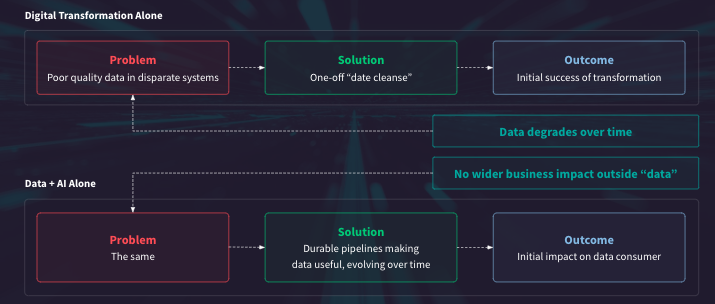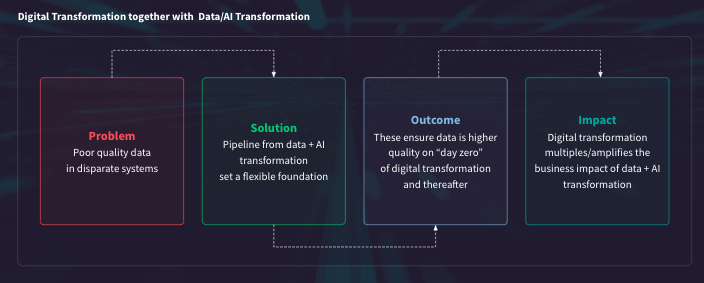Have you ever been part of a digital transformation that did not go so well? The answer is probably yes. Yet the truth is, that the “digital” part of the transformations are generally done quite well these days. There are enough good platforms, enough good ideas, enough people focused on the customer out there who also understand technology, that the “front end” of the exercise can be done very reliably. If your experience involved “shipping an app to revolutionize … something,” then on launch day the app is probably looking good and probably even works.
But because digital transformation budgets tend to be large, and carved kicking and screaming away from lines of business and IT budgets, there’s a heavy incentive to avoid doing the things before launch day to actually make the transformation happen. One of those is to have a really solid plan for both generating the right data, but even more importantly putting that data to work. And it’s that putting the data to work that is a crucial part of the ROI for any digital transformation, because if it costs millions, or 10s or 100s to ship an app, or even multiple apps, then what was it all for?
Digital Transformation; Change at 3 Interlocking Levels
Looking at the definitions of digital transformation below, you might start to see why data is so often left out. Personally, I skew towards those definitions that orient us towards new value, because if we just say “digital transformation is about efficiency” then, first of all, it can get confused with many other things that improve efficiency and, second, if we use a grand word like “transformation,” there should be something new out of it.

The first definition is why organizations should be doing this: it’s still about people, not technology — you only change in order to be able to do other things. The second is about making teams more powerful because the team, however defined, is where people usually feel the strongest sense of attachment and value. Finally, if both of those stand up as motivations, then it is clear that none of this is going to be possible unless individuals change themselves as well. Part of what makes working in this sphere so exciting is the possibility to reinvent yourself many times over as your team and organization change; perhaps even as organizations become ever more digital, the older, functional silos that sometimes made it easier to progress by leaving the organization will dissolve.
What's Behind Digital Transformation Failure?
In our previous blog on the topic, we outlined the two key reasons digital transformations fail: First, the program exists to execute a grand vision, but not enact fundamental change and, second, technology delivery becomes the focus, instead of improvements across the customer experience.
To go back to our app example from earlier, on that launch day, or perhaps the week after, it’s often “the data” that actually shows the first sign of everything cracking, even when “the app” is working fine. And most people know enough to quickly reach for “data quality” as the villain, repeating “garbage in, garbage out.” One place I was working, the transformative app we were delivering relied on some critical third-party data, for which the quality guarantees were basically “yeah, good luck with that” and as soon as the app got in the hands of real people (customers), they were finding those flaws like laser beams.
When these big transformation projects fail, say in HR or finance or procurement, then assuming the interfaces of the new technology are working fine, the way you know it’s going wrong is by interrogating the data, right? Have you ever run parallel processes (untransformed and transformed) side-by-side just for a little while to double-triple-check?
So, Should Digital Transformation and Data/AI Transformation Be Done Separately or Together?
When we do digital transformation and data/AI transformation separately, they reproduce the very problem they were trying to solve. With digital transformation, for example, maybe your “master list” of products is inconsistent across the merged operations of two chains, or employees have multiple employee IDs or customers are vanishing from the data even though they are still buying.
This is typically tackled by digital transformation folks keeping it to themselves and using the tools and experience they have to do a “one-off cleanse” to fix the immediate problems and help deliver initial success.

Meanwhile, there is probably some data team in the same organization using the same data, to report on product performance across the merged operations of the two chains, or generate insight about employee well-being when some people have multiple employee IDs, or even predict the future spending patterns of every single customer.

Turns out they have the exact same data problem deep down, but a very different way of solving it. The data team wants to solve it forever because they HATE staying up late to fix a file of data. The digital transformation person can believe, sometimes, that it’s “just this one time” but the data person has the same problem every time they use that data for something else. The problem for their organization is … they also keep their solution to themselves.
Most perversely, the ultimate stakeholder of BOTH groups could be the SAME business owner and beneficiary of the transformation activity. On the one hand, that person cannot understand why these pesky data quality problems keep leading to delays in roll-outs; meanwhile they keep seeing contradictory results in data presented to them about what is already happening in the business.
When put together, we can see that one group of people has the right business outcome orientation, i.e. “make this transformation successful,” but not the right incentives, experience, or even capability to solve the technical problem in an enduring way. And the other group of people do have the incentive, experience, and capability to solve the technical problem but their mindset is narrowly focused on their own patch.

You probably see an obvious answer already: Wouldn’t it be great if these folks could talk to each other? Has anybody tried moderating that chat?
They operate on different timescales, along different lines of accountability, have too much to do, not enough time, and almost a different way of looking at the world. And so just telling each side of this divide to “share more” or simply putting them under the same leader is unlikely to change much. Another common outcome is that problems of one actually inflate the budgets of the other: Problems on the digital side become easy justification to “put all the data in one place, and then make it perfect quality, once and and for all,” and problems on the data side become an compelling justification to “pay someone external and trustable to fix our data quality problems.”
Both of those solutions — you guessed it — make the future harder. So, what’s the path forward?
Link the Transformations Together for Greater ROI
We believe the answer is to actually make these processes MORE dependent on each other, not LESS dependent. That might sound crazy, but if you’re with me so far, you know digital transformation success depends on data quality (and richness) not just on day one but ongoing, especially as processes change.
Indeed, if the transformation is successful, then the data used to measure it will immediately start to look different to the pre-transformation processes, and manually changing your new data to “look like” your old, so you can compare the two, would be crazy — especially when there are people in the same business whose expertise is precisely in making that automated and painless for you.
But the benefits don’t end there: Part of the point of digital transformation is to actually much better measure what is happening in your business, to further improve it later on, perhaps even continuously. Having transformed one part of your business, you might find new opportunities to optimize or transform another, in a way you had never imagined.

Let’s be clear though: Digital transformation is definitely the larger of the two transformation initiatives. But the point is that the pair is better off together than alone — each covers for the weaknesses of the other and that derisking secures more value. The good news is that relatively small investments in your data transformation can meaningfully increase the ROI on your digital transformation.





